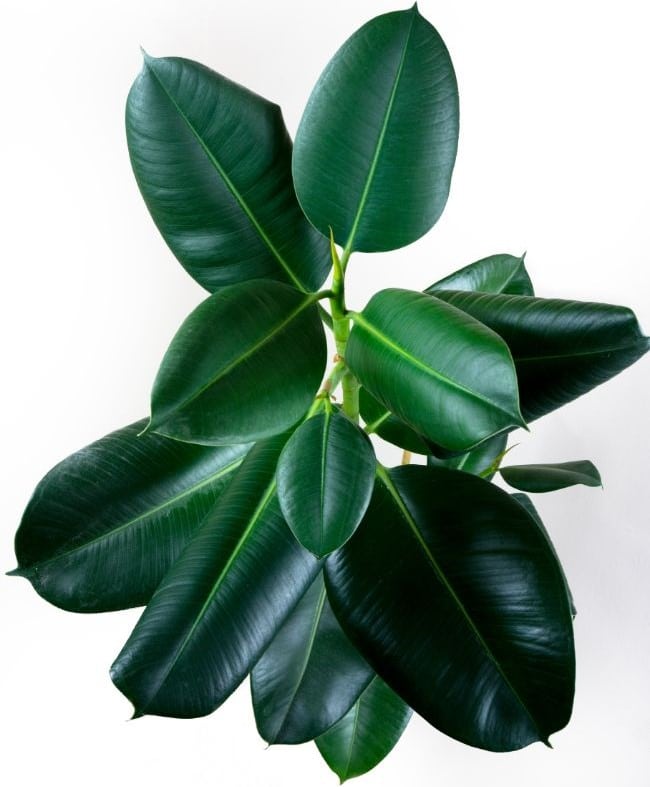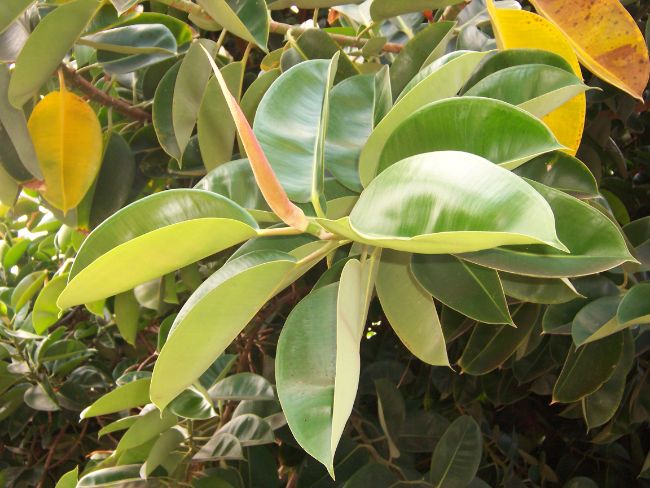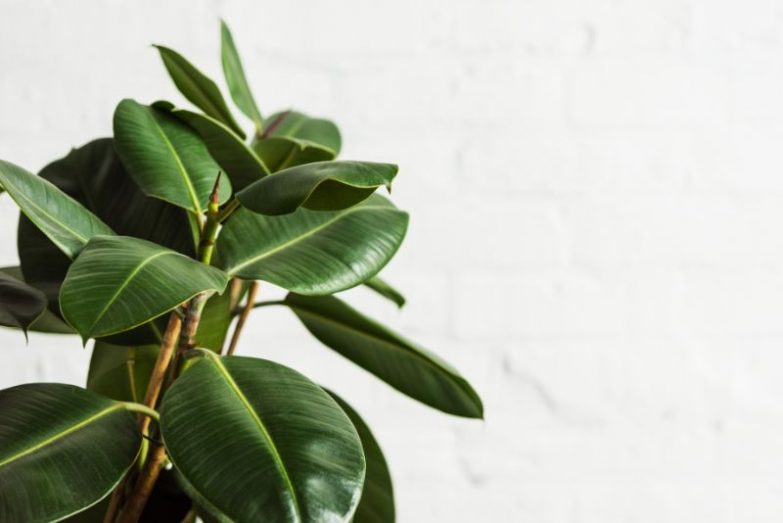Rubber Plants (Ficus elastica) make attractive and bold statements when used as houseplants and are typically hardy and easy to maintain when grown indoors. However, a number of problems can cause curling of your rubber plant leaves, affecting the health and looks of these tropical beauties.
Why Are My Rubber Plant Leaves Curling? The main causes of leaf curling in Rubber Plants are too much light, low humidity, improper watering practices, pests, and cold conditions. Identify and fix the problem by examining the plant carefully and making appropriate changes to care.
7 Reasons Why Your Rubber Plant Leaves Are Curling
If your Rubber Plant’s leaf curling has you scratching your head on what’s wrong, continue reading to learn about the 8 most common reasons and what you can do in regards to prevention and treatment.
You may also like to read my article about general rubber plant care, which covers everything you need to know to keep your rubber plant in great health.
New Growth Is A Normal Cause Of Curling Leaves
One reason for your Rubber Plant to have curling leaves is if it’s developing new growth. This is one problem that is perfectly natural and no cause for concern. As the Rubber Plant develops new immature leaves, they are tightly curled and as the leaf develops, it will uncurl.
If your Rubber Plant is forming new foliage, just sit back and watch because before you know it you will be graced with the large, glossy and robust leaves the plant is known for. Pat yourself on the back because you’re doing something right if your Rubber Plant is developing new foliage.
Too Much Water
Although Rubber Plants appreciate a regular drink during the growing season of spring through summer, too much water can promote leaf curling and at worse, can cause problems with root rot. Overwatering also causes leaf drop. They do not like wet feet and keeping the soil constantly saturated with water. During winter, water requirements will be reduced due to reduced growth and lower temperatures.
If the soil is kept constantly wet and the Rubber Plant develops root rot, your plant will eventually die if the problem isn’t caught and corrected in time. Once the plant starts developing root rot, you’ll need to take immediate action to save your plant.
Probable reasons for too wet conditions include:
- Watering too much
- Soil that doesn’t drain and is too heavy
- A container without drain holes
Solution
To fix rubber plant leaves curling due to conditions that are too wet, water your rubber plant only when the top several inches of soil becomes dry, grow the Rubber Plant in well-draining soil and use containers with bottom drainage.
During the growing season of spring through summer while the Rubber Plant is actively growing you’ll need to water more frequently. During fall and winter, while the plant is dormant or not actively growing, water requirements will be reduced, so take extra care not to overwater.

Underwatering
Just as overwatering your Rubber Plant can cause problems with leaf curl so does the opposite, underwatering the plant. As the plant becomes more stressed due to lack of moisture, the leaves can start curling.
Solution
Although the Rubber Plant is relatively forgiving if you miss a watering or two, regular applications keep those leaves uncurled and the entire plant looking its best.
Read this article about how to tell when houseplants need watering and this one about how often to water houseplants for more information about getting watering just right. Watering problems are by far the most common issues with rubber plants, so it is well worth taking the time to get this right.
Cold Temperatures Can Cause Curling Leaves
Another reason your Rubber Plant may develop curling leaves is due to temperatures that are too cold. Rubber Plants are tropical broadleaf evergreens and when grown outdoors they only thrive in frost-free climates where extreme winter temperatures don’t occur. In addition, leaf drop occurs if temperatures are too cold. Read more about the causes of leaf drop in rubber plants here.
Therefore, they won’t tolerate indoor conditions that are too cold or situated in a location where the plant experiences cold drafts. Rubber Plants are lovers of warmth and thrive when conditions are warm and steady.
Solution
To prevent leaf curling due to indoor conditions being too cold, place the Rubber Plant where year-round temperatures remain between 55°F and 85°F. Additionally, avoid cold drafts and if you gave it a break from indoors and placed the container outside, be sure to bring it back inside before the cold winds of winter come calling. Once temperatures drop below 50°F, the Rubber Plant can suffer cold damage.
Low Humidity
Rubber Plants are native to consistently warm locations that are humid and require indoor humidity to grow properly and look their best. It goes to reason that if humidity is low the Rubber Plant will suffer curling leaves.
Solution
You don’t have to be a humidity expert to give your Rubber Plant the humidity it requires to prevent leaf curl and be the indoor rock star it was meant to be. Some ways to increase humidity around your Rubber Plant include:
- Group other containerized plants around the Rubber Plant.
- Set on a pebble-lined tray that catches water and creates humidity as it evaporates around the Rubber Plant.
- Mist the Rubber Plant with room temperature water several times weekly.
- Grow the Rubber Plant in a room with natural humidity like a bathroom, provided the area receives the appropriate light the plant requires for proper growth.
Read my article about increasing humidity for your indoor plants for more information.
Pest Problems
Another reason for leaf curling in indoor Rubber Plants is an infestation of pests. Mealybugs, scale, and spider mites are common indoor pests and can attack Rubber Plants.
Jumping on the problem as soon as you notice it is the best course of action to prevent further infestations and problems. Identifying pests is simple:
- Mealybugs: Mealybugs pierce the Rubber Plant with their mouthpieces, sucking out the inner juices. They look like clumps of cottony masses and usually show up in the leaf crotches and along the stems.
- Spider Mites: Like mealybugs, spider mites suck out the Rubber Plant’s juices and can quickly cause damage. Spider mites are very small and spin a very fine webbing over the plant, and can quickly transfer to your other indoor plants.
- Scale: Although a bigger problem for outdoor-grown Rubber Plants, sometimes scale insects can transfer indoors. The insects are tiny, oblong and covered in an armor-like shell outer coating. Similar to mealybugs and spider mites, scale insects suck the plant’s inner juices and are found in clumps along the plant’s stems.
Solution
As soon as you notice a pest problem on your Rubber Plant, treat mealybugs and spider mites with insecticidal soap or neem. When it comes to scale insects, it’s best to use a horticultural oil that smothers the pest. Always handle, mix and apply the particular product according to the product label and reapply as suggested.
It’s a good idea to inspect your other plants to make sure the pests haven’t included them on their list of tasty indoor treats.
I’ve written an in-depth article about identifying, treating and preventing common houseplant pests, which you may like to read for more info.

Too Much Light
If both outer sides of your Rubber Plant’s leaves are starting to curl upward and the leaf color is light to a medium green color, it’s getting too much direct sunlight in its current indoor location.
Solution
You can prevent this type of leaf curling by situating your Rubber Plant in an indoor location receiving the plant’s preferred light. For the best growth and looks, place the plant in an indoor location receiving bright but indirect light. It also performs well in rooms with artificial lighting.
However, if your Rubber Plant isn’t getting enough indoor light, the plant has a tendency to grow tall and leggy. You can solve this problem by moving it to a location with more light.
Additionally, if you decide to give the Rubber Plant a bit of a break from growing indoors and place it outside, make sure to place it in a location out of direct sun or the foliage can burn.
Will The Curled Leaves Recover?
This depends on the extent of the damage. Mild curling can certainly recover if you spot the problem quickly enough and take steps to fix the issue. Sometimes, leaves that have been damaged severely and have curled as a result of this are not able to recover. They will eventually drop from the plant.
How To Prevent Curling Leaves On Your Rubber Plant
The main thing is to focus on providing good care. Leaf curling is a sign of plant stress from a variety of sources. Ensuring that you provide your rubber plant with good growing conditions from the start can make it so much easier to keep your plant in good health.
Often placing a plant in unsuitable light or temperatures is a recipe for disaster and will lead to the slow demise of your plant. Thankfully, rubber plants are fairly forgiving to a bit of neglect and imperfect conditions, so are a good choice if you are a less attentive indoor gardener.
Read my full guide to rubber plant care for everything you need to know about keeping your rubber plant in great health.

